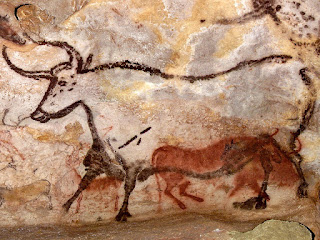 |
|
SOO LINE MOTIVE
|
 |
|
REDRICH AFTERSHOCK
238A
|
In
1627, the last aurochs died in Poland. The largest mammal to walk on the
European Continent after the demise of the Woolly Mammoth, their population was
brought down by increased domestication, interbreeding, disease and old age.
But their lineage has not fallen to the same fate; aurochs genes are alive and
well on almost every continent on earth. So what, exactly, is an aurochs?
To answer this we must look at an animal
that is well known to anyone reading this blog: Aberdeen Angus Cattle. Today,
they stand among the top beef producers in the world (arguably often leading
the charge), with a renown exemplified by the careful selection that goes into
their breeding and upbringing. Yet I often can’t help but wonder when I look at
an impressive Angus bull or a group of newborn calves…where did it all begin?
I’m not going to lie, my background in
agriculture and ranching is pretty limited. I fortunately do not fall into the
category of young people who have never seen a cow, but my childhood experiences
were pretty well limited to our local rodeo and the herd of Herefords that were
always released up behind my house in the springtime. Those large, lumbering
beasts would come in waves around the back fence of our property, and on
occasion we would be woken in the middle of the night by a cow who was
mournfully mooing for her lost calf. One hot summer, two of my friends and I
hopped on the ATV and went for a ride up the old logging road behind my house,
only to come across the herd grazing calmly in a clearing. Little did we know
that, for them, an ATV often meant fresh hay, and we were chased out of there
by a stampede of what must’ve been very eager cattle anticipating a treat we
didn’t possess.
As an Art History and
Visual Studies major, I’ve spent a lot of my time (and education) evaluating
images and researching the history behind events, people and art. If I go as
far back in my memory as Art History 101, among the initial classes I ever took
at University, the first images I studied were of the bulls painted on the walls
of the Lascaux caves in France. It’s remarkable the information you can
accumulate, and my understanding of cattle became much more in depth the
further I strode into my degree. One need only think of the myths of Greece and
the Minotaur or of the bull-headed Apis God of Egypt to see that cattle have
been revered for thousands of years. But, as I discovered last summer, the
selected breeding for the Aberdeen Angus cattle only began in the mid-to-late
19th century. So what, exactly, were they selected from?
This is where the aurochs come in. Although the last pure aurochs
was registered as extinct in 1627 (and was, in fact, the first animal to ever
be official recorded as such), their genetics had been bred into the local
breeds of domesticated and significantly more docile cattle for generations.
The often six foot high, lean, aggressive and intimidatingly horned aurochs did
not allow nor generate an appeal for domestication by themselves, but by
breeding selectively for their more appealing traits – i.e. ruggedness, size,
and local environmental adaptation – they were prime genetics. Subsequently,
the aurochs gene can be found in every single breed of cattle on earth, with yak,
gayal and Bali cattle being the only exceptions. In fact it is the aurochs that
all first-year Art History students will see when studying those caves in
Lascaux.
Today, scientists are attempting to ‘back breed’ present-day cattle
in order to revive the aurochs. An exact replica will never be possible, but
the newly labelled ‘Taurus’ cattle come mighty close – with significantly reduced
aggression. Long legs, lean bodies, curved horns and elongated faces are
starting to roam the European countryside in an attempt by conservationists to
help the ecosystem get back on track. Their grazing on tough plants inedible to
other species and heavy tread help keep grasslands available and plant species
in check.
As
for our beloved Aberdeen Angus? Well, let’s just say that their pleasant
demeanour, excellent meat quality and stocky stature are not quite fitting for
their European counterpart. They’ve come a long way from the ancient aurochs,
and - along with innovative breeders - have created a legacy all their own.
Written by Kiani Evans




